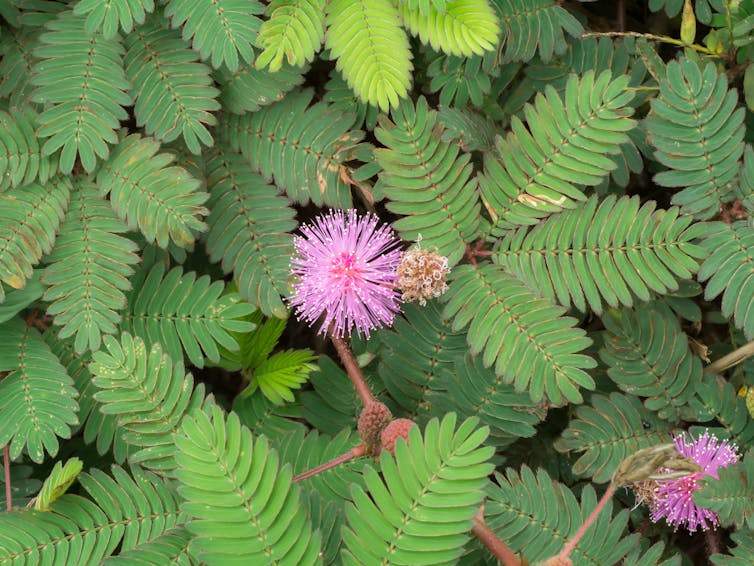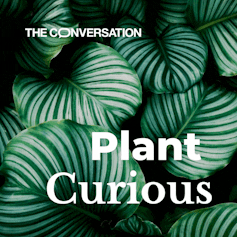
Have you ever had a bad case of jet lag? That horrible feeling when you get off a long haul flight and your body is telling you it’s time to go to sleep, but the outside world is telling you it’s time for breakfast? That’s the biological effects of your inner body clock, also known as your circadian clock.
You can listen to more articles from The Conversation, narrated by Noa, here.
Plants, fungi and even some bacteria have a circadian rhythm too. Although plants don’t tend to hop onto international flights, any living organism with a circadian clock has the potential to get jet lagged. This is more than a fun fact: we could use this information to make crops more productive and tackle food security.
The first reports of an inner body clock in plants stretch back to ancient Greece, when a ship’s captain studied the daily opening and closing of leaves on a tamarind tree. The first systematic observations of plant circadian rhythms were conducted in the 1700s by the French scientist Jean-Jacques d'Ortous de Mairan who studied the rhythmic opening and closing of the leaves of Mimosa pudica (a plant in the pea family).
De Mairan noticed these cycles persisted even when the plant was in constant darkness. This demonstrated the leaf movements were not a response to changes in the lighting conditions, but were controlled by the plant itself. This is the definition of a circadian rhythm.

How plants tell the time
We now know these rhythms are controlled by a genetic network found inside each plant cell. About 20 genes control the circadian rhythm in plants. These genes switch each other on and off in a complicated circuit, generating a 24-hour rhythm.
This control circuit also activates other genes in the plant genome. Some genes are activated at dawn, followed by genes required later in the morning, but switched off by the afternoon. For example, genes associated with photosynthesis are typically activated in the morning to make the most of the daylight, while genes associated with growth and development are normally active at night.
Lab experiments demonstrate that if any of these circadian control genes are mutated (which means their genetic sequence is altered so that they no longer function properly) then the plant’s clock may speed up to give a shorter rhythm, slow down to give a long cycle, or stop functioning altogether.

Many people think of plants as nice-looking greens. Essential for clean air, yes, but simple organisms. A step change in research is shaking up the way scientists think about plants: they are far more complex and more like us than you might imagine. This blossoming field of science is too delightful to do it justice in one or two stories. This article is part of a series, Plant Curious, exploring scientific studies that challenges the way you view plantlife.
Plants with mutated circadian genes not only have faster or slower clocks, but their ability to photosynthesise, grow and reproduce is damaged. A plant with an out of kilter circadian clock will only grow to half the size of a normal plant under laboratory conditions.
Almost every process that scientists have looked at in plants is regulated by the internal clock to some extent. It controls opening and closing of the stomata pores on the underside of a leaf, gas exchange in photosynthesis, shoot and root growth, seasonal flowering and “chemical warfare” between plants and the animals that eat them. This is when some plants produce chemicals that are toxic to animals when ingested.
While most of the research into plant circadian rhythms has been done in the laboratory, there is increasing interest in how this might be applied to agriculture to address the challenges of global food security.
Fit for the future
Global warming is weakening soil health and killing pollinators, while extreme weather and war are among factors pushing up food prices. So this research could become essential to our survival.
Learning more about plants’ circadian clocks could significantly increase crop yield and control the timing of plant flowering to adapt to climate change. For example, several studies have found plants are more sensitive to herbicides depending of the time of day they are applied. Since many plants have similar clocks, we can apply lab findings to crop species.
Several studies have demonstrated that natural alterations in clock genes have been associated with farming breakthroughs. For example, tomatoes were originally farmed in central America where day lengths don’t change much through the year. As people started growing the domesticated tomato in more northerly latitudes, they inadvertently selected a variety with a natural mutation which resulted in a slower clock. That meant the tomato plants were able to make better use of the longer summer days and photosynthesise for longer.

Also, spring (spring sown) and winter (autumn sown) barley flower at different times of year due to a genetic difference in a circadian clock associated gene. Farmers therefore sow different genetic varieties of the same crop in particular seasons to maximise productivity.
With the development of indoor vertical farming, there is huge interest in understanding plant circadian responses to light so that lighting systems can be designed to maximise growth while reducing energy consumption. This is because indoor vertical farming allows for complete control of lighting, unlike when we grow plants outdoors or in our houses. Understanding the plant’s internal rhythm may help optimise plant growth, control the best time for watering, and indicate when to use fertilisers or other chemicals used in farming.
Plants are so much more complex (and perhaps a bit more like us) than a lot of people realise. The last 25 years has seen a huge amount of research into the genetic control mechanisms of the circadian clock. The challenge now is to apply that knowledge to agriculture.
It’s in our interest to make sure we understand plants in this way, because we can use that knowledge to better farm our food and make our crops more resilient.
Katharine Hubbard does not work for, consult, own shares in or receive funding from any company or organisation that would benefit from this article, and has disclosed no relevant affiliations beyond their academic appointment.
This article was originally published on The Conversation. Read the original article.







